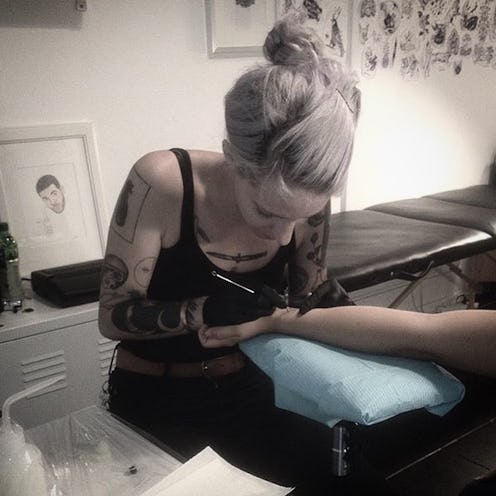
I can't remember my first attempt at DIY tattoos, but I do remember that I had at least a couple before the myths of stick and pokes began to buzz around me. It's not as if everyone I knew was having wild stick and poke parties in college, but I can say that enough of my pals had a steady hand and sick drawing skills to make it an acceptable plan for a Friday night. Stick and pokes often served as a connection between friends and I learned to appreciate the art and memory of my DIY tattoos... and it definitely made me think I was a badass. Unfortunately, my friends and I just weren't that skilled or patient to do anything near as cool as those tats made us appear.
I didn't realized the taboo surrounding stick and pokes until I had to get one of mine fixed up by a professional tattoo artist. After my tat had healed, I went to turn what looked like a tattoo performed in a juvenile detention center into a work of art at the closest parlor that would take me. I ended up with a better tat and a huge lecture from the artist about my high-risk lifestyle. Sure, all tattoos come with risks, but some come with more than others. To be sure, I spoke to professional tattoo artist, Cait Webb, who does hand poked tattoos in Vancouver, BC.
To enlighten those who are strongly against stick and pokes and those who poke unsafely, let these myths serve as a guide on how to poke safely and know that not all stick and pokes are a terrible idea, especially with some amazing professionals out there.
1. All Stick And Pokes Look Bad
Whenever I find out an awesome tattoo was hand poked, I immediately inquire about how to get in touch with the artist. I'm slightly worse than mediocre at them, so anyone who has the patience to spend ample time making sure that the lines are connected and bold is someone I want holding the needle. If you are looking for the aesthetic effect of a stick and poke, there are some amazing artists out there, particularly in Canada. Cait Webb has been hand poking for six years and her take is that stick and pokes are often served as tattoo memorabilia "A lot of people have poorly poked tattoos that they love simply because of the process. These people with terrible stick and poke tattoos usually have some funny, grim or bizarre story behind it, which makes the experience exciting and unique."
2. Stick And Pokes Hurt More Than a Tattoo
This really depends on the person performing the stick and poke, the location of said stick and poke and the tolerance of the person receiving the stick and poke. Personally, I was surprised to read sources that claimed that you bleed more with a stick and poke. I asked Webb her thoughts on the matter and as it turns out a common misconception about stick and pokes is that they hurt way more than machine tats.
"Think of how a tattoo machine applies the tattoo – the needle is dragged along the skin. With hand poked tattoos it is the exact same action except much slower and instead of dragging it is a rhythmic poke, poke, poke. Bottom line: tattoos hurt." She adds that although all tattoos do produce some blood, she has "never had anyone bleed more than usual" when hand poked.
In regards to blood, again it has to do with pressure and in some instances the person. I have never had anyone bleed more than usual. Any kind of tattoo, machine or not, will have some bleeding"
3. Stick And Pokes Are Done With a Safety Pin
Cait Webb mentions that aside from the machine, she's poking with the same tools you can find in a tattoo shop. She advises, "The better the equipment, the better the outcome of the tattoo."
4. The Healing Process Is Brutal
In terms of healing, Webb says that hand poked tattoos often heal within a week, unless there was a lot of black shading. A fresh machine tattoo is like a huge open wound, whereas a fresh hand poked tattoo is more like a scratch, so it may not take as long to heal.
5. Stick And Pokes Require No Preparation
Here's how Webb preps for her pokes: "I often sketch up a design beforehand and make a stencil with tattoo stencil paper. This makes it easier to replace the design many times without hassle. Sterilize any work surface with medical grade sanitizer that kills any air borne or surface dwelling pathogens. Wear gloves not only while tattooing, but also when applying the stencil and setting up [the] work area. [Keep] sharps bin for used needles and keep all supplies in airtight containers in a cabinet." Sound like a lot of work? Well, it's a tattoo that's going to last an eternity, so put a little effort in it for Pete's sake!
6. Stick And Pokes Are Totally Safe
There are risks to any type of tattoo, machine or stick and poke, even when professionally done. As Webb puts it: "If a person is using unsterilized sewing needles, wearing no gloves, drinking, and doing the tattoo in a dingy room with no sanitizer then yes, there are many risks. If someone takes the time to get the proper equipment, including sterilization methods, then there should be minimal risk. With any kind of tattooing there is risk. Often people don’t take care of their tattoos while they are healing, which can lead to infections, fall out or bleeding of the ink." As long as your artist is licensed in his or her craft and you follow their care instructions, then your level of risk is far lower.
Image: Courtesy Cait Webb (2); Kristin Collins Jackson (1); Laurel Adams (1); Tina Campos (1); Elisabeth Waltz (1)